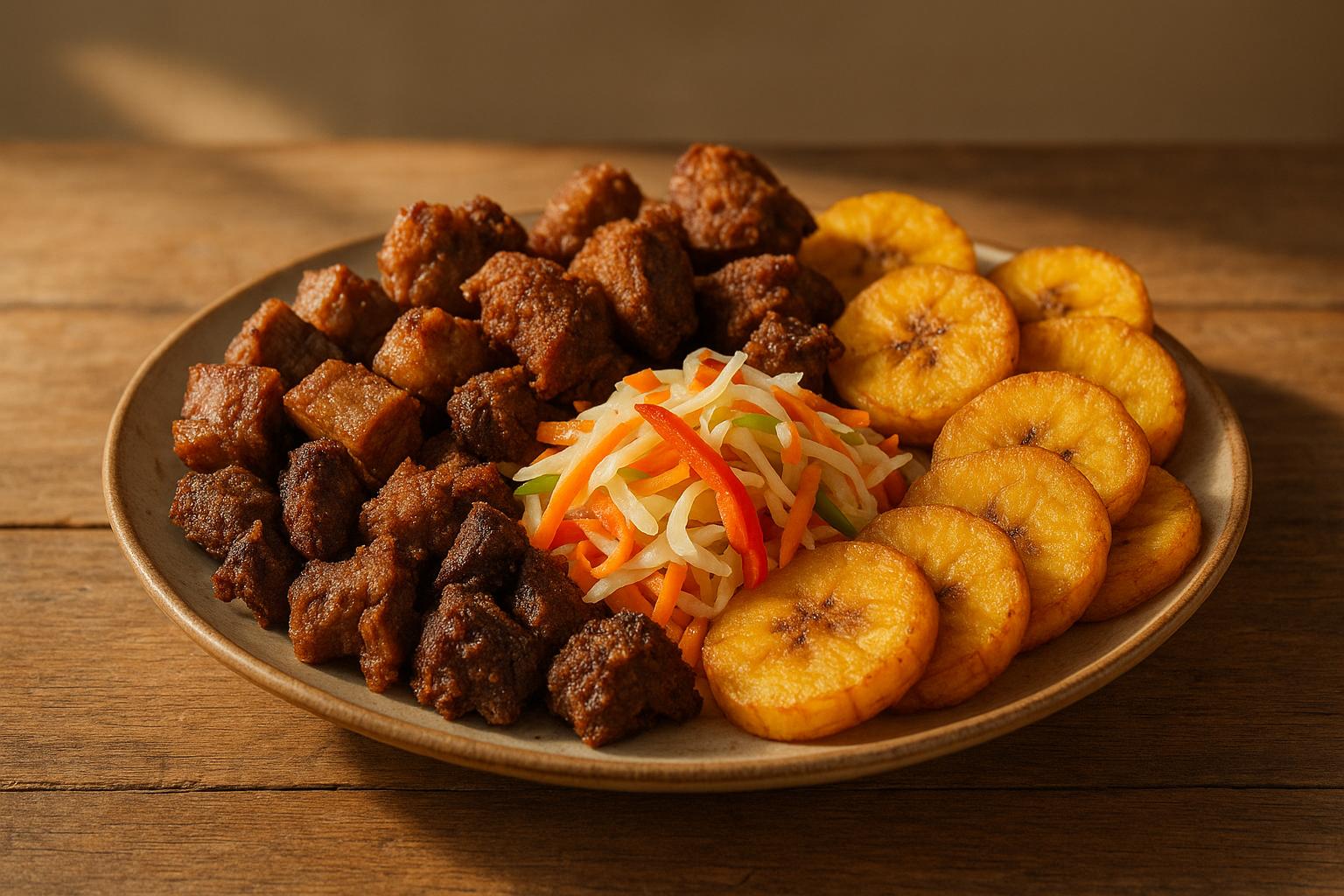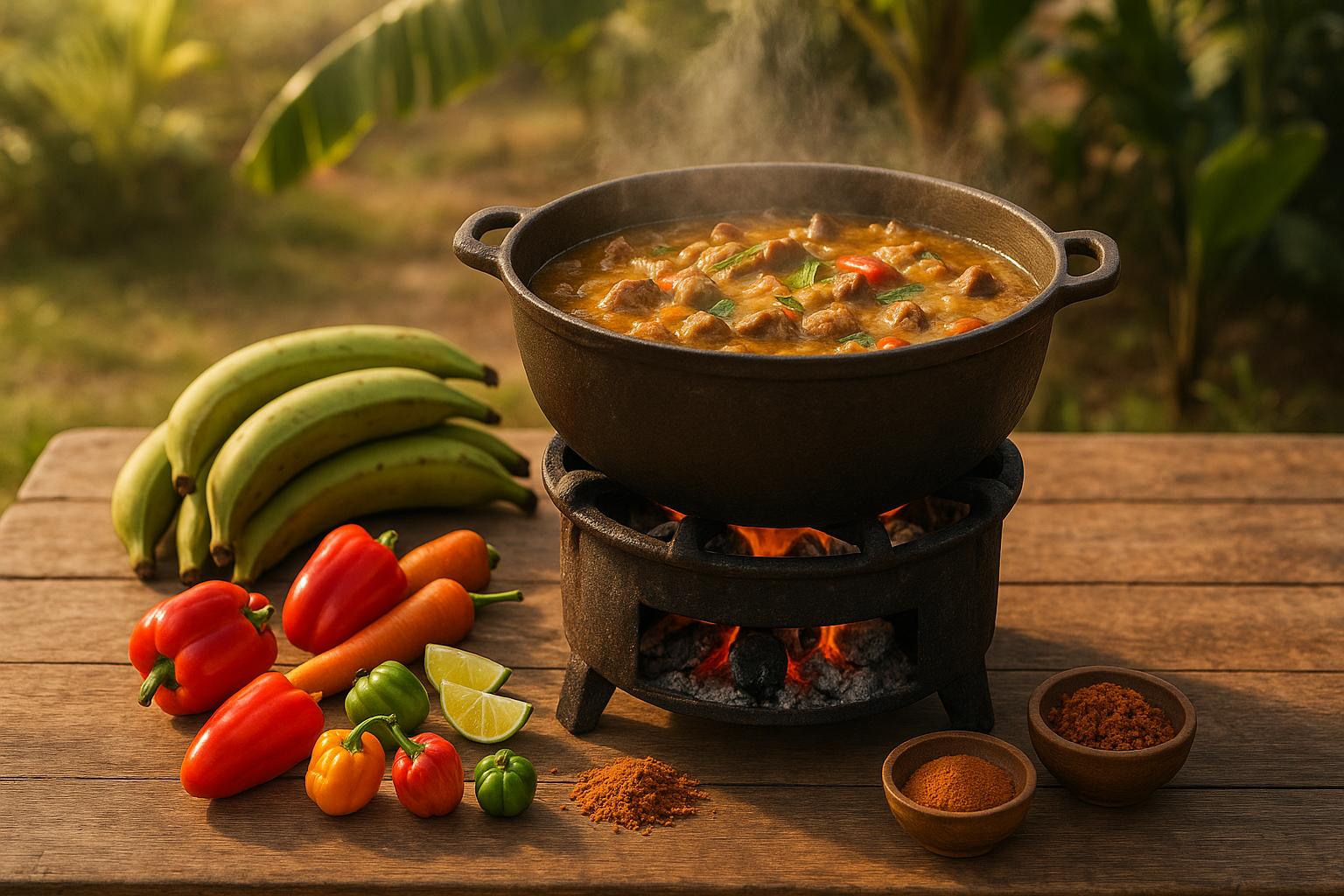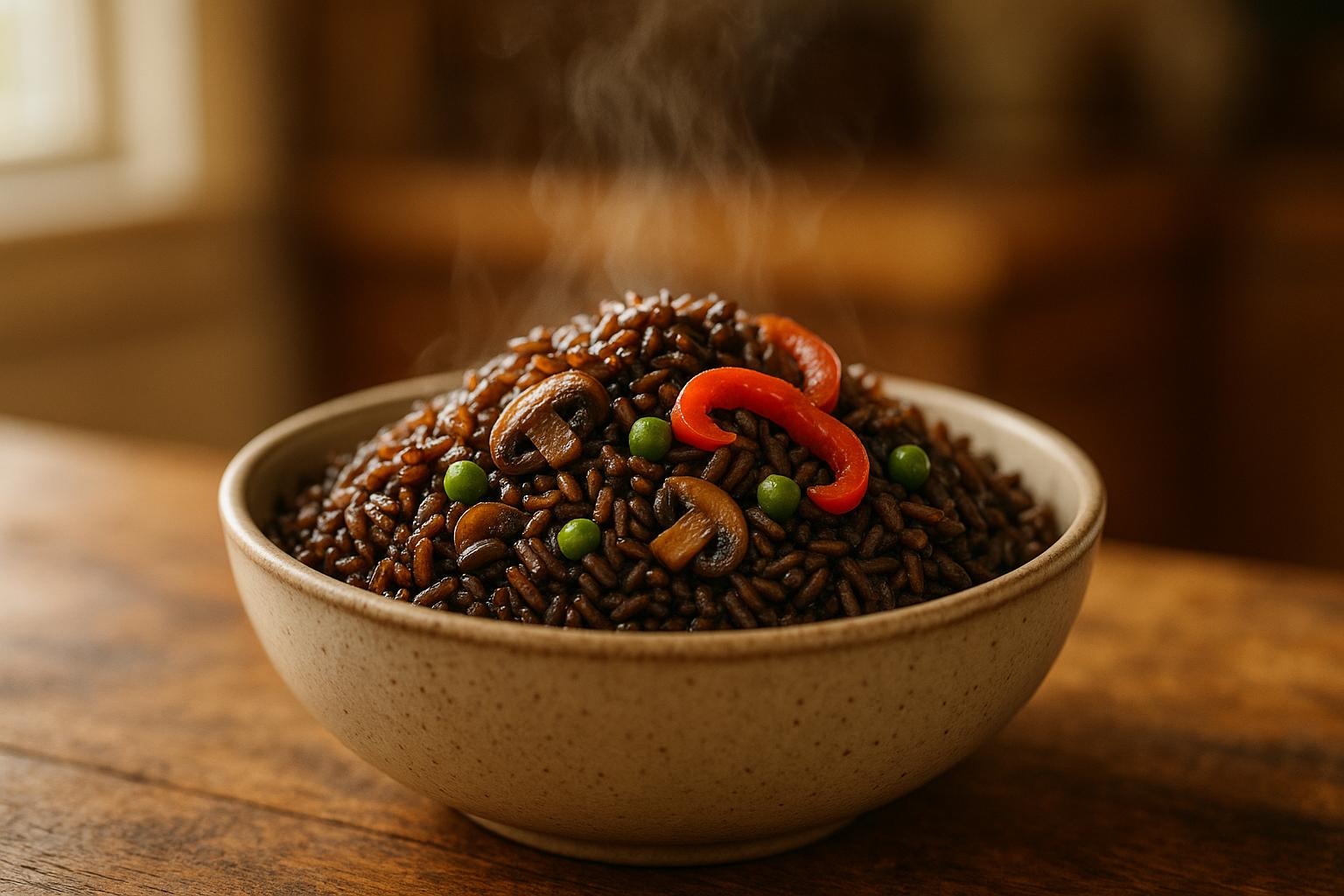Haitian cuisine is a standout in the Caribbean thanks to its bold flavors, unique ingredients, and cooking techniques influenced by French, African, Taíno, and Spanish traditions. While it shares some similarities with other Caribbean cuisines, it has distinct elements that set it apart.
Key Differences Between Haitian and Caribbean Cuisine:
- Seasoning Base: Haitian dishes often use epis, a blend of garlic, green onions, peppers, parsley, and thyme, giving them a unique flavor.
- Spices: Haiti leans heavily on cloves, star anise, and Scotch Bonnet peppers, creating bold and aromatic dishes.
- Signature Dishes: Haitian specialties like Soup Joumou (pumpkin soup) and Diri Djon Djon (black mushroom rice) are unique to the island.
- Cooking Styles: Haitian methods, like marinating and frying meats (griot), differ from other islands' approaches, such as jerk cooking.
- Cultural Symbolism: Dishes like Soup Joumou hold historical significance, symbolizing Haiti's independence.
Quick Comparison:
| Aspect | Haitian Cuisine | General Caribbean Cuisine |
|---|---|---|
| Seasoning Base | Epis (garlic, peppers, herbs) | Varies by region |
| Signature Dishes | Diri Djon Djon, Soup Joumou | Jerk chicken, rice and peas |
| Spices | Cloves, star anise, thyme, Scotch Bonnet | More emphasis on curry and jerk spices |
| Cooking Style | Marinating, braising, frying | Grilling, roasting |
| Cultural Influence | Strong French and African heritage | Varies across islands |
Haitian cuisine reflects its rich history and cultural identity, offering a bold and flavorful experience unlike any other in the Caribbean.
HAITIAN EPIS | GREEN SEASONING | CARIBBEAN SOFRITO ...
Origins and Heritage
Haitian cuisine is a blend of various historical influences. French, African, Spanish, and Taíno traditions have all played a role in shaping the unique food culture of Haiti.
French and African Roots
Haiti's culinary practices were heavily influenced by French colonial history, introducing refined baking techniques and specific ingredients. Meanwhile, African traditions contributed essential ingredients like okra and taro, which are central to Haitian takes on classic dishes, such as the local version of rice and beans (riz et pois).
Mixed Heritage Influences
The fusion of Taíno, Spanish, and African traditions brought about distinct cooking methods that set Haitian cuisine apart. These influences are evident in how ingredients are adapted:
| Ingredient | Common Caribbean Use | Haitian Twist |
|---|---|---|
| Coconut | Desserts and sauces | Integral to Haitian mais moulu |
| Eggplants | Stews and sides | Cooked with the epis seasoning |
| Garlic & Onions | Basic seasoning | Key components of the epis mix |
These ingredient adaptations are reflected in iconic dishes and agricultural practices. For example, Joumou (pumpkin soup) is a powerful symbol of Haiti's independence. During colonial times, French slave-owners forbade Haitians from eating this dish. Unlike other Caribbean versions, Haitian joumou includes chunks of meat and vegetables instead of being pureed into a creamy soup.
Additionally, French colonizers introduced cocoa, coffee, and sugarcane to Haiti, which became staples of the country's cuisine. The methods Haitians developed to prepare these crops continue to set their food apart from other Caribbean traditions.
Ingredients and Methods
Common Haitian Ingredients
Haitian cuisine stands out in the Caribbean for its distinct flavors, shaped by key ingredients and techniques. While it shares some staples with neighboring islands, it introduces unique elements that set it apart. For example, black rice gets its dark color and earthy flavor from locally grown mushrooms - a technique specific to Haiti.
Haitian cooking is built on several essential components:
- Starches: Rice and beans are a staple, especially black rice paired with red beans.
- Fresh produce: Ingredients like coconuts, mangos, avocados, limes, and oranges are locally sourced and widely used.
- Proteins: Salted pork, crab meat, and various meats feature prominently in classic dishes.
Spice and Seasoning Differences
Haitian cuisine is known for its bold and flavorful seasoning. At its heart is epis, a versatile seasoning base made from garlic, green onions, peppers, parsley, and thyme. This blend is a signature element that sets Haitian dishes apart from other Caribbean marinades. The use of specific spices also defines its unique flavor:
| Seasoning Element | Haitian Usage | Caribbean Variation |
|---|---|---|
| Scotch Bonnet | Primary source of heat | Used differently across islands |
| Cloves & Star Anise | Key spices in many dishes | Less commonly used elsewhere |
| Thyme | A vital part of epis | Applied differently in other regions |
| Curry | Present but not dominant | More prominent in areas with East Indian influence |
These spices not only add depth but also reflect Haiti’s culinary identity.
Cooking Methods
Haitian cooking methods, particularly for meat, are distinctive. A popular example is griot, where pork is boiled until tender and then fried to achieve a crispy exterior. Similarly, Tasso - made from beef, goat, or turkey - is marinated and fried to balance crispness with a juicy interior.
Traditional condiments also play a major role in Haitian cuisine. Pikliz, a spicy pickled vegetable mix, is made with a specific blend of vegetables and spices, giving it a flavor that is unmistakably Haitian.
Main Dishes Compared
Popular Haitian Meals
Griot is a beloved dish in Haiti, showcasing the country's unique way of preparing meat. The process includes washing the meat, marinating it with citrus and epis (a Haitian seasoning blend), braising it, and finally frying it to achieve a crispy exterior.
Diri Djon Djon is a black rice dish that gets its color and flavor from local mushrooms. It’s often cooked with lima beans or green peas, cashews, shallots, garlic, and a blend of traditional spices.
Bouillon is a hearty stew that merges French culinary techniques with Haitian ingredients. It combines beef and seafood with vegetables like spinach, potatoes, cassava, carrots, and plantains, creating a rich and flavorful dish.
Similar Caribbean Dishes
Although many Caribbean islands feature comparable dishes, Haiti’s cooking methods and flavor profiles give its cuisine a distinct identity. Here's how Haitian dishes compare to their regional counterparts:
| Dish Type | Haitian Version | Caribbean Counterpart | Key Differences |
|---|---|---|---|
| Pork Dish | Griot | Jerk Pork | Marinated in citrus, braised, and fried; often served with pikliz (spicy pickled vegetables) |
| Rice Dish | Diri Djon Djon | Rice and Peas | Colored with Haiti-specific mushrooms and includes cashews and lima beans |
| Stew | Bouillon | Island Stews | Combines seafood and beef with local vegetables using French-inspired techniques |
These distinctions highlight Haiti's rich culinary traditions. For example, while rice and beans are common across the Caribbean, Haiti's diri ak djon djon stands out with its signature dark color and mushroom-infused taste, which are unique to the island.
"La Paix Bakery offers Bouillon, described as a culinary journey through the heart of Haiti, bursting with the robust flavors of meats, vegetables, and aromatic spices".
sbb-itb-80c33ff
Taste and Regional Differences
Haitian Flavor Elements
Haitian cuisine is known for its bold and spicy flavors, deeply influenced by African and French culinary traditions. At the heart of many Haitian dishes is epis - a cooked mixture of peppers, garlic, green onions, thyme, and parsley. This seasoning mix is the backbone of the cuisine, shaping its robust taste.
Here’s a breakdown of typical Haitian seasonings:
| Base Ingredients | Aromatics | Additional Seasonings |
|---|---|---|
| Bell peppers | Thyme | Maggi bouillon cubes |
| Scotch Bonnet peppers | Star anise | Tomato paste |
| Garlic | Cloves | Chicken bouillon |
| Onions | Cinnamon | Salt and pepper |
Haiti's Local Variations
Across Haiti, regional takes on traditional recipes bring even more variety to the table. For example, pikliz - a spicy condiment made of pickled cabbage, onion, carrot, and Scotch Bonnet peppers - is a staple that adds a fiery kick to many meals. This condiment highlights how local adaptations can add depth and character to Haitian cuisine.
Caribbean Flavor Comparison
Haiti’s cuisine stands out even within the Caribbean. While many Caribbean countries use similar ingredients, Haiti’s approach to preparation and seasoning makes its dishes unique. The heavy use of herbs and peppers creates a flavor profile that is distinctly Haitian. Influences from African, French, Taíno, Spanish, and Arab cultures further enrich its culinary identity.
The combination of epis and seasonings like Maggi bouillon cubes forms a flavor base that’s unmistakably Haitian.
Social Impact of Haitian Food
Community and Identity
Haitian cuisine is deeply tied to culture, heritage, and community. It carries stories of resilience and liberation, uniting Haitians both at home and abroad in a way that other Caribbean cuisines might not.
"It means everything to me, because it is the essence of who I am, what I represent, and my heritage. Haitian culture is vibrant, full of stories and history".
"Haitian food culture is an expression of identity, resilience, and community. It is the way we honor our history, celebrate life, and connect with each other. It's not just about food - it's about storytelling, pride, and preserving a legacy that blends African, Indigenous, French, and Caribbean influences".
Certain dishes hold symbolic value, marking significant occasions. For example, Soup Joumou is traditionally enjoyed on Independence Day, symbolizing Haiti's history and fight for freedom. While these traditions remain strong, modern interpretations are reshaping the culinary narrative.
Modern Changes
Haitian cuisine continues to evolve, blending its traditional roots with contemporary influences. This shift is evident in several aspects:
| Traditional Element | Modern Adaptation | Impact |
|---|---|---|
| Family recipes | Professional chefs sharing knowledge | Broader recognition |
| Local ingredients | Access to global ingredients | Fusion of flavors |
| Community gatherings | Online food communities | Promotes cultural awareness |
"Unlike any other Caribbean country, Haiti's cuisine is complex because of the slave trade, migration, spices trade, and more. We have heavy African, French, Spanish, and even Middle Eastern influences, which create a very unique blend of flavors".
Modern Haitian chefs stay true to traditional techniques while making the cuisine more accessible to younger generations.
"Haitian food is a labor of love".
This dedication to preserving the past while embracing modern elements helps Haitian cuisine stand out as a rich and diverse part of Caribbean culture.
Conclusion
Haitian cuisine stands out in the Caribbean thanks to its distinct blend of cultural influences and cooking techniques. Its deep historical roots and bold culinary approaches make it unique among its regional counterparts.
Here’s how Haitian cuisine compares:
| Aspect | Haitian Cuisine | General Caribbean Cuisine |
|---|---|---|
| Cultural Influences | Strong mix of French, African, Taino, and Spanish | Varies by region, generally less French influence |
| Signature Base | Uses "epice" (garlic, green onions, peppers, parsley, thyme) | Seasoning bases differ across regions |
| Unique Dishes | Riz djon djon, Soup Joumou | Regional specialties |
| Cooking Style | Focus on bold spices and hearty preparations | Methods vary by island and heritage |
Signature dishes further highlight these differences. For instance, Haiti’s Soup Joumou combines chunky meat and vegetables, unlike the cream-based pumpkin soups found in other regions. The use of local ingredients, such as black djon djon mushrooms, reflects a culinary style rooted in tradition and creativity.
These characteristics underscore Haitian cuisine’s unique identity within the Caribbean, blending regional staples with its own bold flavors and time-honored techniques.
FAQs
What ingredients make Haitian cuisine unique compared to other Caribbean cuisines?
Haitian cuisine stands out for its use of epis, a flavorful seasoning blend made from ingredients like garlic, green onions, bell peppers, parsley, and thyme. This aromatic mix forms the base for many Haitian dishes and gives them a distinct taste.
Another unique feature of Haitian cooking is the use of djon djon mushrooms, which are used to prepare the iconic dish riz djon djon (black mushroom rice). These mushrooms give the rice its rich, earthy flavor and dark color, making it a standout in Haitian culinary traditions.
Haitian food also incorporates bold spices and techniques that reflect its African, French, and Caribbean influences, creating a vibrant and unique flavor profile that sets it apart from other cuisines in the region.
What cultural influences have shaped Haitian cuisine, and how do they make it unique?
Haitian cuisine is a rich fusion of cultural influences from the Taíno, African, French, and Spanish traditions, creating its unique flavor and identity. The Taíno people contributed native ingredients like cassava and peppers, while African influences introduced staples such as okra, taro, and bold spices. French colonization left its mark with refined cooking techniques, pastries, and the use of cheeses, while Spanish settlers brought new ingredients and preparation methods.
This blend of cultures has resulted in a cuisine known for its vibrant flavors, creative use of local ingredients, and dishes like griot (fried pork), diri ak djon djon (black mushroom rice), and pikliz (spicy pickled vegetables). Each influence adds depth to Haitian food, making it a standout within the broader Caribbean culinary landscape.
What makes Soup Joumou special in Haitian culture, and how is it different from other Caribbean soups?
Soup Joumou is a cherished symbol of freedom and resilience in Haitian culture. Traditionally enjoyed on January 1st, Haiti's Independence Day, this pumpkin-based soup celebrates the nation's liberation from French colonial rule. Once a dish reserved for enslavers, it became a powerful emblem of independence after Haiti's victory in 1804.
While similar soups exist across the Caribbean, Soup Joumou is unique due to its historical significance and rich, flavorful ingredients. It typically includes pumpkin or squash, beef, pasta, vegetables, and a blend of spices. The cultural meaning behind the dish sets it apart, making it more than just a meal - it's a celebration of Haitian identity and pride.


